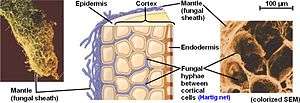Hartig net
Hartig net is a network of inward growing hyphae, that extends into the root, penetrating between the epidermis and cortex of ectomycorrhizal plants[1]. This network is a site of nutrient exchange between the fungus and the host plant.[2] The Hartig net is one of the three components required for ectomycorrhizal roots to form as part of ectomycorrhizal symbiosis with the host tree or plant.[3]

The Hartig net is named after Theodor Hartig[4] [5] , a 19th-century German forest biologist and botanist. He reported research in 1842 on the anatomy of the interface between ectomycorrhizal fungi and tree roots.
The Hartig net supplies chemical elements required for plant growth, such as potassium, [6], and provides compounds, such as nitrate, [7] used in combination with the ectomycorrhizal symbiosis for farmable crops, as well as certain kinds of lichens. [8] Part of its role in mutualistic interactions is based on the chemicals it provides,[9] as well as it being essential for bi-directional nutritional uptake [10], which has shown to help defend the fungi from heavy metal damage, [11] amongst other benefits.
See also
References
- Smith, Sally, Read, David (2002). "Chapter 6: Structure and Development of Ectomycorrhizal roots". Mycorrhizal Symbiosis. IV–V: 163–232. doi:10.1016/B978-012652840-4/50007-3 – via ScienceDirect.
- Carlile, M.J. & Watkinson, S.C. (1994) The Fungi. Academic Press Ltd, London. pp 329 - 340.
- Becquer, Adeline; Guerro-Galan, Carmen (2019). "Chapter Three: The Ectomychorrhizal contribution to tree nutrition". Advances in Botanical Research. 89: 77–126. doi:10.1016/bs.abr.2018.11.003.
- Money, Nicholas P (2011). Mushroom. Oxford: Oxford University Press. p. 71.
- Maser, C; Claridge, A W; Trappe, J M (2008). Trees, Truffles, and Beasts: How Forests Function. New Brunswick: Rutgers University Press. p. 54.
- Maria del Carmen Guerrero-Galan, Gabriella Houdinet, Amandine Delteil, Kevin Garcia, Sabine Zimmermann. Unravelling nutrient exchange in ectomycorrhizal symbiosis contributing to plant potassium nutrition. International Conference Saclay Plant Sciences (SPS) 2018, Jul 2018, Paris, France. ⟨hal-01843727⟩
- Sa, G., Yao, J., Deng, C., Liu, J., Zhang, Y., Zhu, Z., Zhang, Y., Ma, X., Zhao, R., Lin, S., Lu, C., Polle, A. and Chen, S. (2019), Amelioration of nitrate uptake under salt stress by ectomycorrhiza with and without a Hartig net. New Phytol, 222: 1951-1964. doi:10.1111/nph.15740
- Roy, R., Reinders, A., Ward, J. M., & McDonald, T. R. (2020). Understanding transport processes in lichen, Azolla-cyanobacteria, ectomycorrhiza, endomycorrhiza, and rhizobia-legume symbiotic interactions. F1000Research, 9, F1000 Faculty Rev-39. https://doi.org/10.12688/f1000research.19740.1
- Guerrero‐Galán, C., Delteil, A., Garcia, K., Houdinet, G., Conéjéro, G., Gaillard, I., Sentenac, H. and Zimmermann, S.D. (2018), Plant potassium nutrition in ectomycorrhizal symbiosis: properties and roles of the three fungal TOK potassium channels in Hebeloma cylindrosporum. Environ Microbiol, 20: 1873-1887. doi:10.1111/1462-2920.14122
- Smith, G.R., Finlay, R.D., Stenlid, J., Vasaitis, R. and Menkis, A. (2017), Growing evidence for facultative biotrophy in saprotrophic fungi: data from microcosm tests with 201 species of wood‐decay basidiomycetes. New Phytol, 215: 747-755. doi:10.1111/nph.14551
- Shi, W, Zhang, Y, Chen, S, Polle, A, Rennenberg, H, Luo, Z‐B. Physiological and molecular mechanisms of heavy metal accumulation in nonmycorrhizal versus mycorrhizal plants. Plant Cell Environ. 2019; 42: 1087– 1103. https://doi.org/10.1111/pce.13471